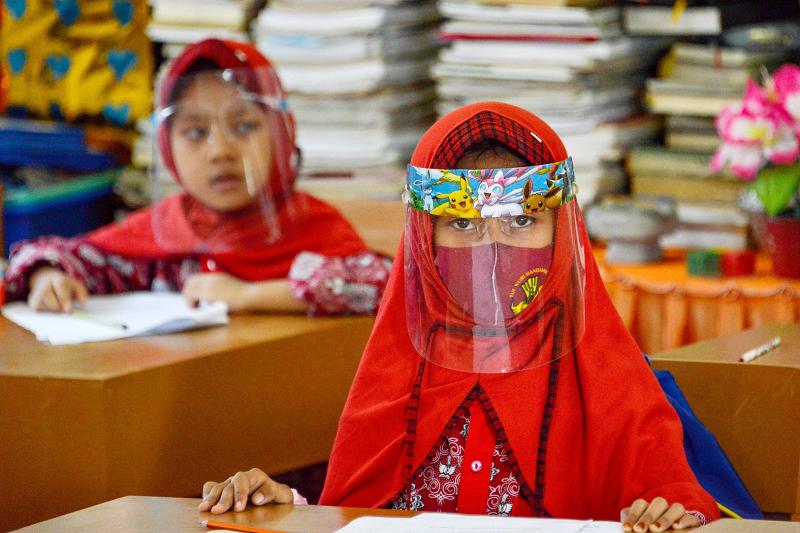Sardjono Utomo, a senior Indonesian physician, late on Tuesday afternoon admitted himself to his local hospital in East Java.
In just over 24 hours, as his fellow doctors phoned hospital after hospital in search of a ventilator in Surabaya — Indonesia’s second-largest city and a few hours’ drive away — the doctor and his wife, Sri Martini, would both be dead.
The death of Sardjono and his wife from COVID-19 has raised alarm bells in the world’s fourth-most populated nation, where the pandemic has steadily gone from bad to worse and is putting a significant strain on the country’s poorly equipped healthcare system.

Photo: AFP
In the past 10 days, Indonesia has posted four daily record-high numbers, the highest was on Thursday with 8,369 new cases, while local news channels have run headlines of more regional hospitals reaching capacity.
“It seems like the current overcapacity situation is the worst it has been throughout the pandemic in Indonesia,” Indonesian Medical Association spokesman Halik Malik said.
Public health experts have said that Indonesia has struggled since March to get the pandemic under control, now with 563,680 cases and 17,479 confirmed deaths — plus another nearly 70,000 suspected cases — it has by far the highest caseload and death toll in Southeast Asia, and the data show that the situation is intensifying.

Photo: Arif Rahman / via Reuters
In Pamekasan, a modest district on Madura bordered by the Java Sea, where Sardjono worked for years as a hospital director, there is not even one ventilator.
However, when the 67-year-old radiologist arrived at Pamekasan’s Muhamad Noer Hospital, he desperately needed one.
“Everywhere was full — and everything is full here in Pamekasan,” said pulmonologist Syaiful Hidayat, who treated Sardjono. “Now it is peaking.”
Sardjono’s son-in-law, 41-year-old Arif Rahman, said the deaths of his in-laws highlighted how ill-equipped the nation’s hospitals were to handle the pandemic.
“Ventilators are important,” he said, “In Pamekasan, which is a referral for other regions, it is of course pitiful. Let alone in other places like Surabaya, where it is always full.”
Asked why Sardjono could not find a ventilator, Surabaya government spokesman Febriadhitya Prajatara said they had tried too late, and the city was not to blame.
In the capital, there is also cause for concern.
LaporCOVID-19, an independent coronavirus data initiative, this week said that Jakarta’s emergency wards were veering toward “collapse.”
In helping coronavirus patients find hospital beds from Nov. 27 to Nov. 29, LaporCOVID-19 contacted emergency wards at 69 hospitals and discovered that 97 percent were full.
Asked why a senior doctor was unable to receive the treatment he needed, Syaiful said there was just not enough room.
“Who do you want to kick out?” he asked. “You can’t do that. It shows that COVID is here and it is real… It can happen to anyone and we won’t have enough beds.”

‘IN A DIFFERENT PLACE’: The envoy first visited Shanghai, where he attended a Chinese basketball playoff match, and is to meet top officials in Beijing tomorrow US Secretary of State Antony Blinken yesterday arrived in China on his second visit in a year as the US ramps up pressure on its rival over its support for Russia while also seeking to manage tensions with Beijing. The US diplomat tomorrow is to meet China’s top brass in Beijing, where he is also expected to plead for restraint as Taiwan inaugurates president-elect William Lai (賴清德), and to raise US concerns on Chinese trade practices. However, Blinken is also seeking to stabilize ties, with tensions between the world’s two largest economies easing since his previous visit in June last year. At the
Nearly half of China’s major cities are suffering “moderate to severe” levels of subsidence, putting millions of people at risk of flooding, especially as sea levels rise, according to a study of nationwide satellite data released yesterday. The authors of the paper, published by the journal Science, found that 45 percent of China’s urban land was sinking faster than 3mm per year, with 16 percent at more than 10mm per year, driven not only by declining water tables, but also the sheer weight of the built environment. With China’s urban population already in excess of 900 million people, “even a small portion

UNSETTLING IMAGES: The scene took place in front of TV crews covering the Trump trial, with a CNN anchor calling it an ‘emotional and unbelievably disturbing moment’ A man who doused himself in an accelerant and set himself on fire outside the courthouse where former US president Donald Trump is on trial has died, police said yesterday. The New York City Police Department (NYPD) said the man was declared dead by staff at an area hospital. The man was in Collect Pond Park at about 1:30pm on Friday when he took out pamphlets espousing conspiracy theories, tossed them around, then doused himself in an accelerant and set himself on fire, officials and witnesses said. A large number of police officers were nearby when it happened. Some officers and bystanders rushed

Beijing is continuing to commit genocide and crimes against humanity against Uyghurs and other Muslim minorities in its western Xinjiang province, U.S. Secretary of State Antony Blinken said in a report published on Monday, ahead of his planned visit to China this week. The State Department’s annual human rights report, which documents abuses recorded all over the world during the previous calendar year, repeated language from previous years on the treatment of Muslims in Xinjiang, but the publication raises the issue ahead of delicate talks, including on the war in Ukraine and global trade, between the top U.S. diplomat and Chinese